Spot Guide South Africa: The best windsurfing spots around Cape Town - from waves to flat water
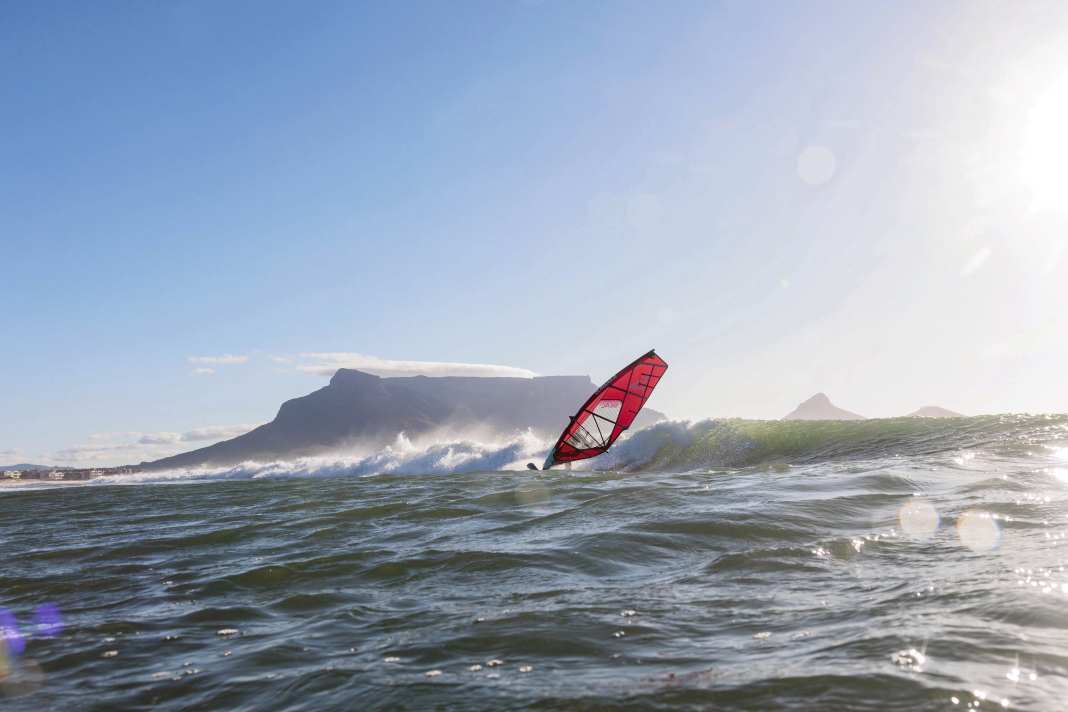





Cape Town has been my second home for more than 20 years. This is where I train, produce content for my sponsors, organise wave camps and immerse myself in the unique interplay of wind, waves and nature. Hardly any other place in the world offers such a variety of conditions in such a short distance - from perfect wave spots and freeride areas to shallow lagoons for beginners and foilers.
But Cape Town is much more than just a windsurfing paradise. It is a city of contrasts. While some of the wealthiest neighbourhoods in Africa are located directly on the white sandy beaches, around a third of the population lives in simple townships. South Africa is one of the countries with the highest levels of social inequality in the world. Despite these contrasts, Cape Town is a mostly safe environment for windsurfers. The best spots are located in the more affluent coastal regions, such as Blouberg, Big Bay or Scarborough, where it is easy to move around. Although the crime rate is undeniably high, it mainly affects the townships or certain neighbourhoods that windsurfers avoid anyway. If you stick to the usual safety rules - i.e. don't walk at night and don't leave valuables in your car - you will experience the same relaxed atmosphere in the surfing hotspots as in other popular windsurfing destinations around the world.
Cape Town challenges, inspires and is addictive.
After a session, there are countless ways to round off the day - be it with a sundowner in Bloubergstrand, a dinner on the Waterfront or an exploration tour through the city. Cape Town is challenging, inspiring and addictive. In this guide, I'll show you the best spots, explain the wind system and give you valuable tips on how to get the most out of your time in the Cape. Whether you're a beginner or a pro, Cape Town is guaranteed to cast a spell over you.
Catching the perfect day - experience counts
Sometimes, despite all the forecasts, there can be no wind in Table Bay for a week. It has taken years to really understand which spots work best with which tide, wave direction and wind direction. Sometimes a forecast looks perfect, but in reality the wind is gusty, the waves aren't running clean or the current makes it unpredictable. The best strategy? Stick to experienced Cape Town locals or head out with the information in this guide and discover for yourself.
If you're mobile locally, you can almost always get out on the water around Cape Town."
I had many of my best sessions on days when I didn't really have any great expectations, but went out on the water anyway. If you understand the wind cycle and remain flexible, you can surf almost every day in Cape Town. It's not always the perfect forecasts that make for the best sessions - it's often spontaneous decisions that make the difference and stay in your memory.
Cape Town rewards those who adapt, remain flexible and respect the magic of nature. Every session here is an adventure, be it on the legendary waves of Witsands, epic jumps in Big Bay or a downwind session along the coast. Once you've surfed here, you'll keep coming back.
Maybe we'll see each other on the water or at one of my wave camps. See you in the water!
Your Flo
The best windsurfing spots around Cape Town
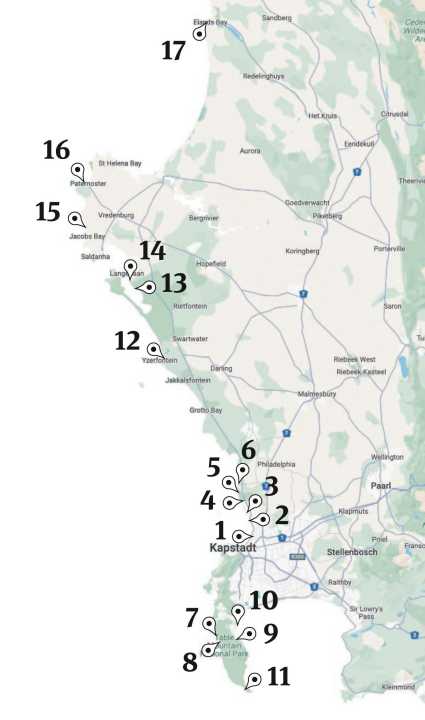
Table Bay & West Coast - the classics for south-easterly winds
When the Cape Doctor blows with full force from the south-east, the spots at Table Bay and along the west coast are the first choice. The conditions vary depending on wind strength, wave size and time of day.
1st Milnerton Lighthouse
-33.8816, 18.4872
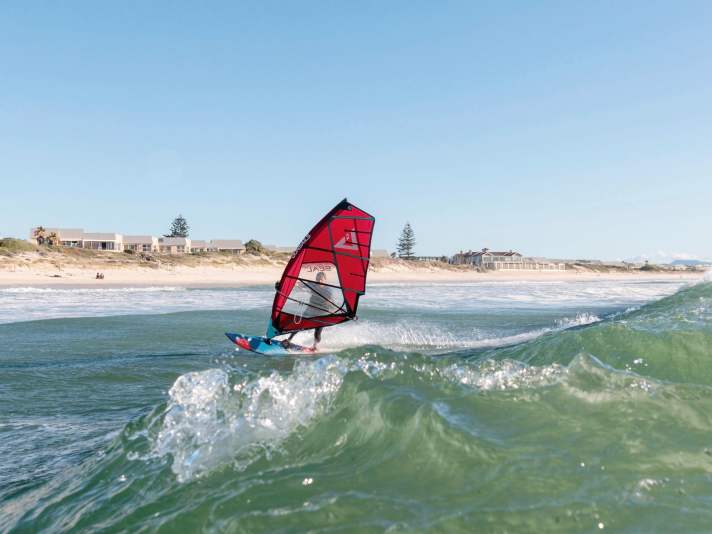
Milnerton is the first spot to catch the wind when the southeaster sets in, and is located south of Sunset on Woodbrigde Island. There are some catering and parking facilities on site, but you shouldn't leave any valuables in your car here, even if the car park attendants look trustworthy. The wind blows a little more offshore here than at Sunset Beach, which means it is often gusty in the shore area. The south-west swell is noticeably blocked and is therefore smaller than at Sunset Beach or Melkbos. However, as soon as the swell is big or westerly enough, the Milnerton beach break is in top form. The way out then requires experience; once on the wave, however, turns like a hot knife through butter are possible, as the waves run clean and the offshore wind blows the water walls as smooth as glass.

2. sunset beach
-33.8543, 18.4893
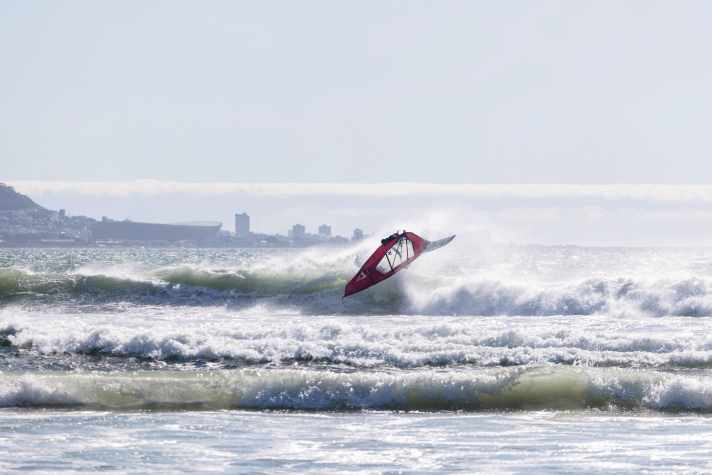
Probably the most famous spot around Cape Town is the posh suburb of Sunset Beach! You can set up at various car parks. The wind here is usually slightly side-offshore, which means it can be gusty in the shore area. The entry is via sand and is easy, but the breakers in the shore area can be quite challenging. Those who master these are rewarded with great waves, which break over an offshore sandbank and can be between one and five metres high, depending on the swell. However, it often remains moderate and rideable for less experienced wave surfers. Sunset is the spot that can be approached first when the south-easterly wind sets in, alongside Milnerton, and is particularly suitable for riding waves, sometimes also for jumping. In the high season, it can get really crowded here, and when the wind picks up on strong days, the crowd moves on to Haakgat or Melkbos.

3. Rietvlei Lake
-33.8362, 18.4934
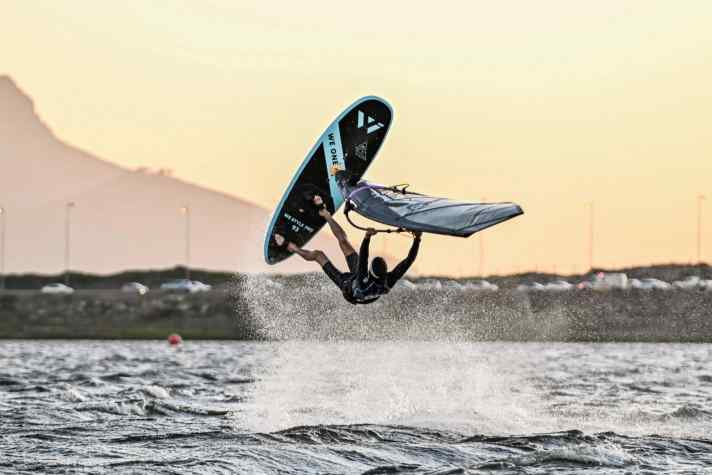
The inland lake just before Tableview cannot be overlooked from the main road. This spot is particularly popular with foilers, slalom racers and freestylers. The water quality can vary and you shouldn't necessarily drink the water as algae can sometimes appear. However, the water is significantly warmer than the open ocean. Similar to Milnerton or Sunset Beach, the south-easterly wind usually kicks in first here - ideal for a morning session. There is a meadow for rigging, parking and launching at the Milnerton Aquatic Club, a club area with a small entrance fee. Depending on the wind strength, the water ranges from smooth to choppy, and in strong winds a short, steep wave pushes across the lake and the freestylers catapult themselves spectacularly into the air. On typical Southeaster days, the wind often shifts here in the afternoon and the smallest wipes are ridden.

4. big bay
-33.7933, 18.4576
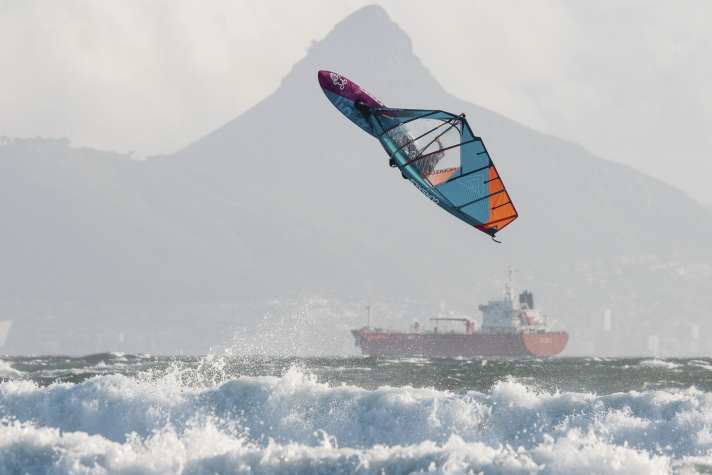
Big Bay, probably the smallest bay in the Cape region, has blossomed into a hipster neighbourhood over the years. Directly behind the beach there is a mall with cafés and shopping facilities, and you can also live here in style - even non-surfing company can have a good time here. Big Bay works best with a south-easterly wind with a medium swell. The wind here is slightly weaker than at Sunset, but comes in sideshore to slightly sideonshore - perfect for jumping! The spot is framed by rocks that you shouldn't get too close to. It gets crowded in high season, as Big Bay is also very popular with kiters.

5th Haakgat
-33.7509, 18.4421

Haakgat is the place to go when it gets increasingly rough in Milnerton and at Sunset Beach, as the wind is much weaker here. If you arrive too late, you have to park on the road, as the small car park fills up quickly. The entrance is sandy, the wave breaks cleanly on a reef a little to the left of it as a point break. The current is strong and the wind tends to be gusty in the shore area. On big days, the waves here can be well over the height of a mast. The spot is therefore often more suitable for very experienced wave surfers.

6th Melkbosstrand
-33.7086, 18.4433
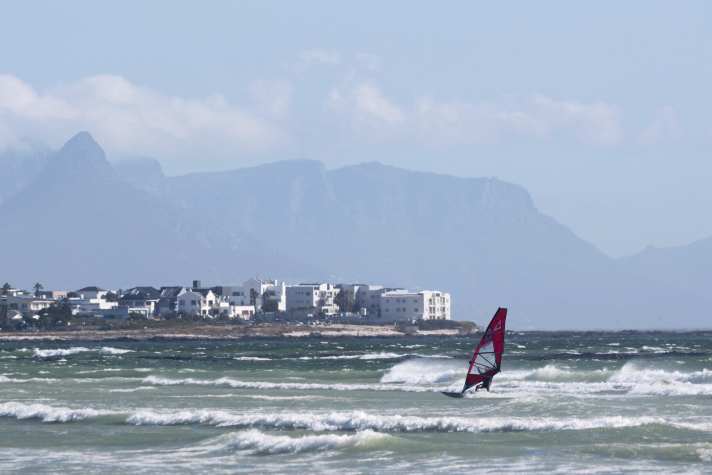
On days with a strong southeasterly, many people skip the morning session at Sunset and come directly to Melkbos, as the wind starts later here and is significantly weaker - which doesn't mean that the smallest sails aren't regularly used here. With a large car park and a wide sandy beach, there is always plenty of space here. The spot is particularly suitable for days with small waves and when there is too much wind at spots like Sunset. The wave can be powerful, but also offers longer wave rides of several turns. It is one of the most consistent spots around Cape Town, because even on days with little swell there is always something rolling in, which is why Melkbos is so popular. When the swell is big, a lot of white water blocks the way out and makes for long swims.

Cape Peninsula & False Bay - bigger waves, wild ambience
If the wind shifts more to the east-southeast or if there is a day with a north-westerly wind, the spots on the Cape Peninsula and in False Bay come into play. They often offer more powerful and bigger waves than Table Bay.
7. witsands
-34.1767, 18.3532
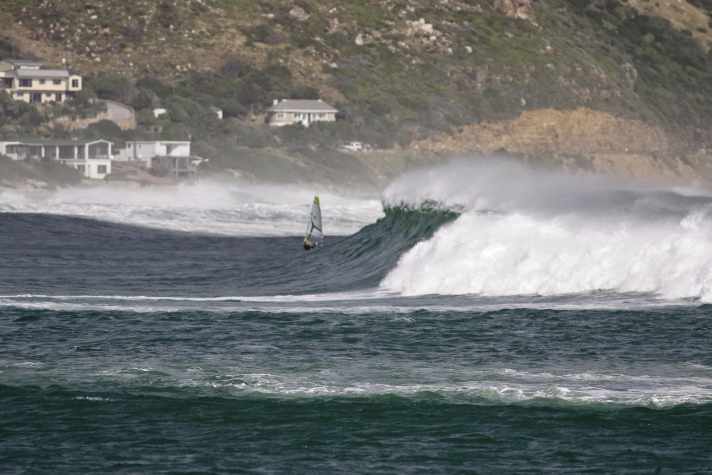
Witsands offers a wonderful backdrop with a white beach and steep mountains. You can park on the main road, from here a steep staircase leads down to the beach. Valuables should not be left in the car, as there are occasional reports of theft. In Witsands you can feel the full force of the Atlantic, even with a small swell there are always a few lines running. The south-easterly wind comes in sideshore to slightly sideonshore, blows constantly and is often strong, making Witsands one of the best jumping spots in the region. Depending on the tide, some shorebreak and powerful wave sections can be quite challenging. In southerly wind directions, the wind becomes much gusty and lighter. However, the best conditions in Witsands are found in westerly to west-north-westerly winds and thick swell. Then perfect lines run into the bay and the offshore wind blows them as smooth as glass. Wave experts then show aerials and crashing cutbacks. However, if you miss the exit, you will be washed ashore in the slipstream over the rocks of Misty Cliffs - no fun!

8th Scarborough Beach
-34.1990, 18.3723
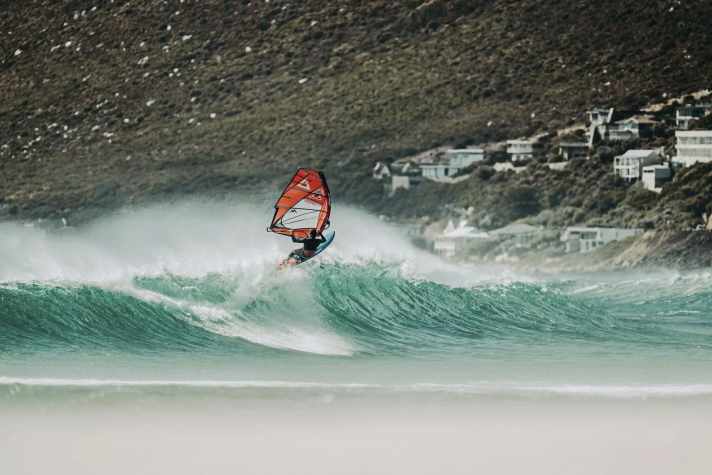
World-class ambience, world-class spot - if the conditions are right. Southeasterly winds blow offshore and gusty in the shore area, the beach break is an additional obstacle. The point break at the left end of the bay rarely comes to life - it needs a big, westerly swell. When it does, however, the sets can be more than mast-high and endless rides on smoothly blown faces are possible. But crashes often end in the kelp or on the rocks! The beach break, on the other hand, also works with small swells and is a one-hit wonder - usually only one turn or aerial is possible. The surfers are on the left, so it's better to keep your distance here. You can park behind the picturesque beach, and there are also accommodation and catering options in the village.

9th Simon's Town - Long Beach
-34.1876, 18.4261
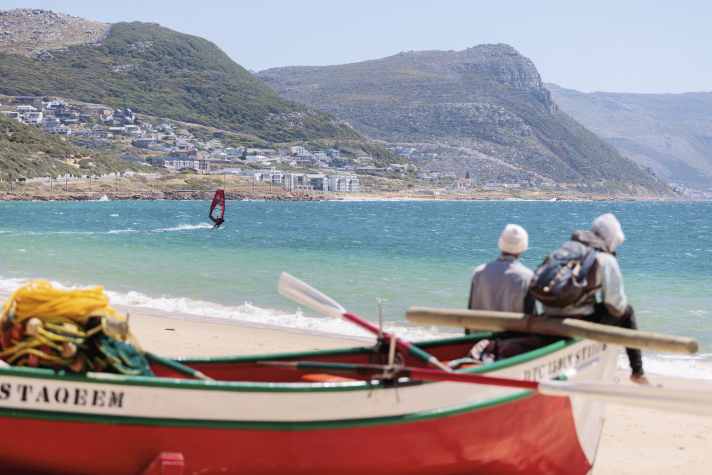
The greater Cape Town area also offers flat water spots - perhaps the best is Simon's Town. In order for the wind to get around the harbour to the east, there should be a proper south-easterly or even east-south-easterly wind. You can park directly near the water, but for safety's sake you should not leave any valuables visible in the car. The conditions on the long, white sandy beach are definitely worth a visit; depending on the wind strength, there are flat water to bump & jump conditions with wind from the right. With moderate winds, intermediates and foilers also get their money's worth here, and the water is significantly warmer than on the west coast. If you're lucky, you might even see whales passing by, especially in November and December. There is also some infrastructure, accommodation and cafés at the spot.

10th Glencairn
-34.1596, 18.4313

In False Bay, just before Simon's Town, lies Glencairn, a largely unknown spot. The small, sheltered bay is a tip, especially when the wind only blows slightly to the east, i.e. particularly south of the Cape Peninsula. The conditions here are then reminiscent of Pozo, only with wind from the right. You can park in Glencairn directly behind the beach, a small tunnel takes you under the railway tracks to the beach. It's best to get in far to the right of the sandy beach, as the south-south-easterly wind is still coming diagonally onshore, so you still have enough space to leeward. The conditions are particularly suitable for jumping, as a short, steep wave arrives in Glencairn. The water here is also a more pleasant temperature than on the west coast. As with other spots on the Cape Peninsula, camera equipment and expensive mobile phones are best left out of sight in the car!

11th Platboom
-34.3403, 18.4588
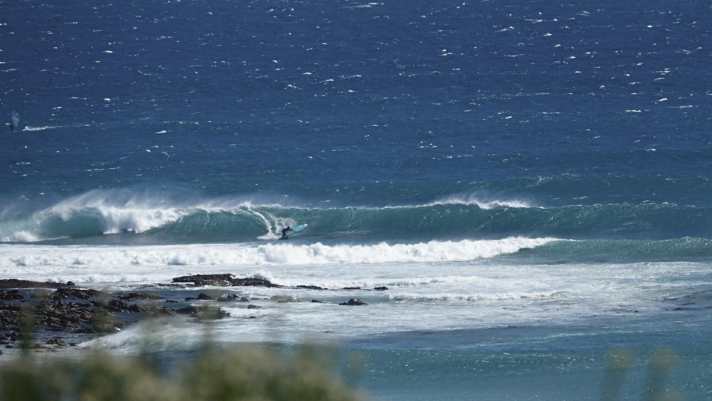
Platboom is located in the Cape Point National Park and there is an entrance fee. The landscape is spectacular, the bay just before the Cape of Good Hope offers powerful, clean waves - a real adventure in the midst of wild nature. There is no infrastructure whatsoever. Platboom is often the last spot where the wind holds out in a south-easterly cycle. You enter the water at the southern end of the bay via a small sandy beach, where a small path leads to. The best wind direction is east-south-east with a south swell. High tide should be avoided here, as the waves then break very close to the rocks, making it difficult to land. The shore area is still gusty and the entrance is framed by thick rocks. Ideally, you should pull some height from the entrance into the left-hand part of the bay. When the swell is big, some monstrous sets hit the coast here. Given that you also have to hit the narrow exit point and the next piece of land is downwind of Argentina, you should know what you're doing here.

Northern west coast - perfect with westerly and south-westerly winds
When the wind comes from the south-west or west, the northern spots of Cape Town offer ideal conditions. These are a little further away, but reward you with endless beaches and epic waves.
12th Yzerfontein
-33.3414, 18.1610
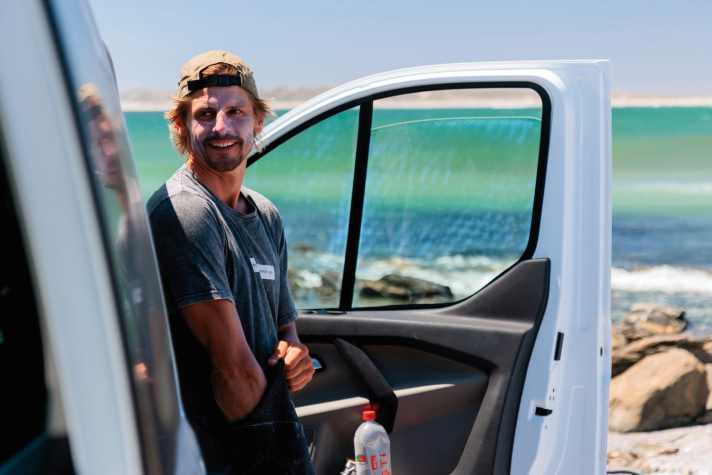
Yzerfontain is located around 45 minutes north of Cape Town. You won't know whether it's worth the trip until you get there, because "Yzer" is a diva and probably the most difficult spot in the region to predict. The south-easterly wind is always much weaker here than in Cape Town and Langebaan, so in principle the trip makes sense if it becomes unrideable at the other spots. Nevertheless, it can happen that you set off from CPT in 40 knots and it's calm in Yzer. You park directly behind the long sandy beach, the waves can get big with south-west swell, but also break super clean over a sandbank, perfect for endless rides with numerous turns. Because the wave runs out on sand, the spot is not particularly difficult to surf. Those who have caught Yzerfontein at its peak claim that it is one of the best waves in the entire region.

13th Langebaan Shark Bay
-33.1122, 18.0445
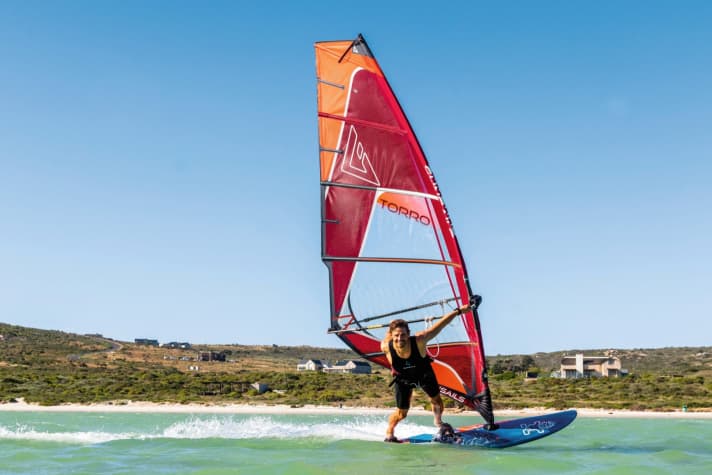
There are actually lots of sharks here - but only completely harmless fellows that like to burrow into the sand and are barely bigger than a flounder. Shark Bay is also a wonderful and relaxed spot that is completely shielded from the waves, some of which are standing deep, and which also boasts warmer water. The spot, which is very popular with kiters, is particularly worth a visit when the wind is westerly or even north-westerly, i.e. when the usual Cape Town spots are in the doldrums. Because Shark Bay is located between two mountain ranges, the wind blows through here and a 12-knot forecast quickly turns into a wonderful flat water day with 20 knots. When the water is outgoing, the current pushes against the wind, and westerly and north-westerly winds feel even stronger. The opposite is true when the water is rising. A normal south-easterly wind is also very rideable here and somewhat weaker than on the main beach in Langebaan. You can park along the road or in a small car park, from where a short footpath leads to the beach.

14 Langebaan
-33.0819, 18.0326
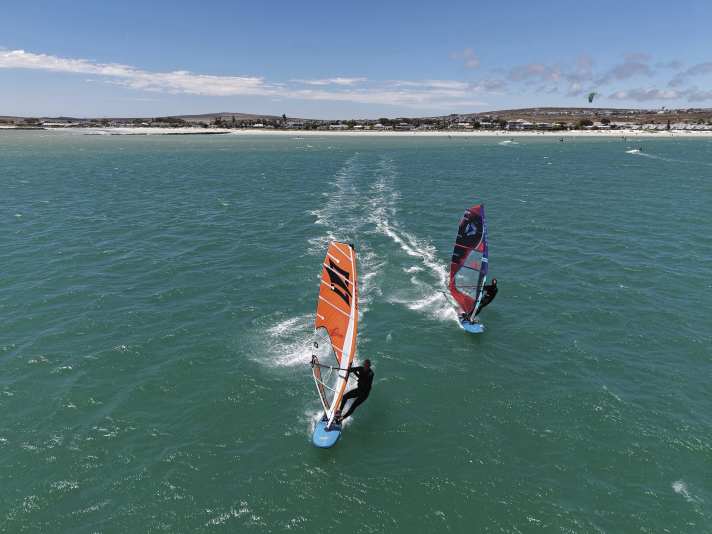
Langebaan has been one of the surf test spots for over 20 years - and for good reason. The town, located around 1:30 hours' drive north of Cape Town, offers such a good overall package that you can pitch your tent here permanently. Supermarkets, a surf school, restaurants and shopping facilities are available directly on site, and things are much more relaxed here than in the metropolis of Cape Town. Langebaan also scores with a very large wind window and varied conditions: Normal winds from the south to south-east are as strong as in Cape Town and come sideshore from the left. The entrance in front of the Cape Sports Centre is flat and sandy, and at low tide there is even a small standing area. A headland blocks the wind waves so that you can celebrate your manoeuvres and freestyle tricks in the mirror-smooth water for the first 200 metres. Further out, depending on the tide, it gets a little choppier, but if you want, you can make long runs towards the opposite shore. The swell in Langebaan is smaller than at the exposed spots. However, when a westerly or very large south-westerly swell is approaching, there are always clean lines turning into the bay. Directly downwind of the two headlands, you can then do turns or aerials on clean wave faces. A real wave spot with sideshore wind can be found in the surrounding area in Swartriet or at Club Mykonos. This offers nice jumping conditions upwind of a holiday resort with south-easterly winds, swell and low water. South-west, west and north-west winds are also strengthened locally in Langebaan due to the surrounding hills, so you can still get a good session here even if the spots around Cape Town don't get any wind. The bay usually offers bump & jump conditions on such days, and a visit to nearby Shark Bay is also recommended!

15 Swartriet
-32.9483, 17.8874

Even during the high season, there is much less going on here than around Cape Town. This is mainly due to the fact that Swartriet is located in a private resort. There is an entrance fee at the gate, but the spot is one of the most beautiful on the entire west coast: framed by rocks, it is a white, flat sandy beach with turquoise-coloured water. The ideal swell is from the south-west, which turns around the headland into the bay. It usually blows a little lighter than in Langebaan or Cape Town, which can definitely be an advantage. For Swartriet to work, the wind should not blow from the south-west, but from the south or south-south-east. Then the wind blows the waves perfectly smooth. At low tide, the reef in front of the small ruin is quite shallow, so it is better to go further upwind of the bay over sand. Swartriet allows great wave rides, aerials and sometimes, a little further downwind, even jumps. Generally speaking, the waves are cleaner but smaller in the left-hand part of the bay; further to the right, the waves are bigger but less clean. If the forecast is good, it is worth staying directly in the beach houses. Then you can windsurf non-stop and don't have to leave the resort at 5 pm, as is usually the case.

16. paternoster
-32.8029, 17.8997
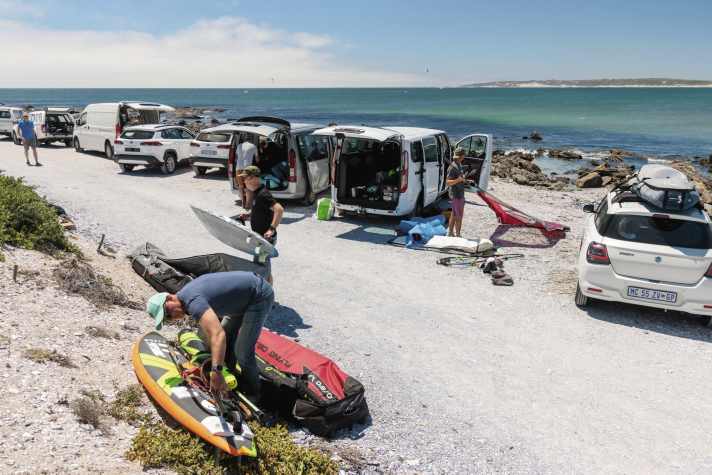
A delicacy of the west coast! The south-easterly wind blows fully offshore, which is why Paternoster is only approached when the wind blows from the south to south-west. Because the bay opens up to the north, the bigger and more westerly the swell, the better. With a typical south-westerly swell of two metres, it is never worth travelling here. Park at the northern edge of the village. Clean waves run into the bay behind a small rocky outcrop at swell and ideally low tide, the Sideoffshore wind blows the faces smooth - a dream for anyone looking for clean, long waves to ride. When the swell is big, it can get epic, but then you shouldn't start your rides too close to the rocks. The entry is flat and sandy, but the wind near the shore is often light and gusty.

17th Elands Bay
-32.3142, 18.3378

On sunny, warm (!) days, a local thermal develops in Elands Bay, which sets in at midday and blows sideshore to slightly side-offshore. You can park directly on the beach. When the swell is small, the beach break offers choppy sections, but breaks on sand. As soon as the set waves become over logohigh, the point break begins to break off the coast. On the best days, this connects with the point break at the left end of the bay - there are then monstrous sets outside and mirror-smooth lines for several turns further in. Important: Watch out for the surfers and show respect! On the big days, the beach break already operates a natural selection at the entrance. There is some infrastructure and even a small campsite in Elands Bay.

- Also interesting: Cape Town's alternative spots with shallow water
Area information South Africa/Cape Town
Arrival
Cape Town is easily accessible with its international airport. Airlines such as Condor fly regularly to South Africa and also offer the option of bringing equipment with you - as always, check the airlines' baggage conditions, register surf equipment in good time and adhere to the specified dimensions and weights. As you should be mobile on site, it is advisable to bring your own equipment, as there are no large rental centres in Cape Town - with the exception of Langebaan. A hire car is recommended to explore the spots and the area.
Living
The region offers countless accommodation options in all price ranges. However, as the streets of the metropolis are clogged during rush hour, it is advisable to stay in a strategic location, ideally in a hostel or flat north of the city centre. Good starting points are the Tableview, Sunset Beach or Big Bay neighbourhoods, as this is where the wind picks up earliest in the morning. You will also find a good selection of restaurants and live away from the hustle and bustle. If you want to escape the hustle and bustle of the city, you can stay at the Langebaan multispot, about an hour to the north.
Wind & Weather
Cape Town owes its legendary wind conditions to the "Cape Doctor", a strong south-easterly trade wind that provides constant winds between November and April. It is created by the temperature difference between the hot inland and the cool Atlantic Ocean. While the high pressure area over the ocean remains stable, the sun heats up the interior, creating a thermal effect that draws the air masses from the sea inland. The mountains around Cape Town further intensify this wind - with the result that it often hits the coast with full force. Typically, the wind blows in cycles of three to four days before it dies down for one or two days. Sometimes an approaching area of low pressure brings a day of north-westerly winds before the next south-easterly cycle builds up. The wind changes slightly in position and direction during the cycle, which has a direct impact on the best spots. In the first two days of a wind cycle, the wind belt is centred on the northern Table Bay. Then Milnerton, Sunset Beach, Big Bay and Melkbos are the best spots. The wind comes from the south-southeast, is constant and less gusty. While it still blows moderately in the morning, the Cape Doctor unleashes its full force from midday onwards. 30 to 40 knots are not uncommon - small sails are always a must! From the third day onwards, the wind system often shifts slightly. The wind shifts to the east-southeast, making Table Bay less favourable, while the Cape Peninsula with spots such as Witsands, Scarborough and Platboom come into focus. Platboom, located in the Cape Point National Park, is often the only spot where the wind still holds out at the end of the cycle. Sometimes there is still no wind in Cape Town and Witsands and less than ten kilometres further on, in Platboom, you are surfing with a 3.7 sail.

After these three to four days of strong south-easterly winds, there is usually a break of one to two days during which the wind dies down. But even then there are alternatives. Langebaan with Shark Bay and Main Beach almost always offers good conditions for freeride or foil sessions. The official wind statistics for Cape Town in the winter months show around 60 per cent planing wind. However, experience has shown that those who are mobile locally can get out on the water much more often.
While the air temperatures between November and March are usually between 20 and 30 degrees, the water is comparatively fresh at 13 to 15 degrees. A long 4/3 wetsuit is usually perfect for windsurfing; if you also want to go surfing, you should bring a bonnet, surf shoes and possibly an undergarment.
Shafts
The low-pressure areas in the South Atlantic are the wave machine for the spots around Cape Town. It is not impossible for it to be completely flat between December and March, but it is very rare. Depending on the swell and the chosen spot, days ranging from knee-high to well over mast-high are possible. If there is no swell from the south, south-west or west, Witsands and Platboom on the Cape Peninsula still catch wind waves. There is (almost) always at least one small ramp in Melkbos.
Surf schools & shops
There are no classic rental centres in Cape Town, only in Langebaan (capesports.co.za) and on the Rietvlej (windsurfingcapetown.wixsite.com) are contact points.
Surf shops offer a wider range of products:
Board repairs are possible at the Cape Doctor (capedr.co.za), sail repairs for example at secondwindsails.com.
Alternative programme
Cape Town combines African, Indian and even Caribbean influences into a fascinating whole. The cultural diversity can be seen and tasted at the weekly Old Bis cuit Mill Market in the Woodstock district. On top of this, the region can impress with its incredible natural wonders. A trip to the Cape of Good Hope, a hike on Table Mountain or Lions Head or a visit to the wine estates in the hinterland and the Kirstenbosch Botanical Garden are just some of the countless worthwhile destinations. You can also immerse yourself in the turbulent (and not always positive) history of the country in Cape Town: In the District Sixth Museum or on Robben Island, the prison island where Nelson Mandela spent 18 years in detention, the dark chapter of apartheid becomes tangible.
Good to know
When you hear South Africa, you usually think of great white sharks. However, sightings on the west coast are rare, not to mention attacks on surfers or swimmers.
The issue of crime cannot be denied - there is a reason why every house has a fence, barred windows and an alarm system. Nevertheless, it is generally safe to walk around the spots, but night-time strolls are not recommended.

